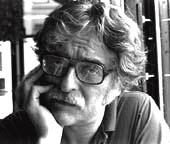Bill Pierce
Nuts & Bolts
Do You Use a
Hammer or a Saw
|

|
The
other day I was asked a question that I haven't heard for a good many
years. "What camera do you use?"
I wonder
if surgeons are ever asked what tool they use? "Do you use a scalpel
or sutures?" How about a carpenter? "Did you build those shelves
with a hammer or a saw?"
Probably the most used camera in photojournalism is the 35-mm single
lens reflex. While it's not best for everything, it is probably the
single most versatile camera made. Add autofocus, auto exposure and
a motor, and it's the great butt-saver for the harried photojournalist.
No wonder some of the better digital still cameras use the SLR film
cameras as their platforms.
But, it's a less than perfect world. A giant conspiracy of gadget bag
and carrying case manufacturers, assisted by those camera manufacturers
that do not make 35-mm single lens reflexes, have made sure that a photojournalist
will carry a heavy burden if he wants to do it all.
Herein are some of the cameras that often come out of my over-packed
cases. An 8x10 view camera: At first glance, there's no real reason
to use the big box on a journalistic shoot. Admittedly, a 16x20 or 20x24
print from an 8x10 negative can be staggering. But you're not going
to stagger when you see an 8x10 camera image in the local paper. However,
that big a camera stops a subject in his tracks. The celebrity that
is used to being gunned by motorized SLRs and believes he knows more
about photographing himself than you do (he may be right), is a true
pain in the butt when it comes to getting good and/or different pictures
of him. Pull out your 8x10 and say, "Look into the lens and hold
still. I am the master here." Works every time. Greg Heisler taught
me this stunt. He does it even better than I do because he has an 11x14
view.
By
the way, I often use a 4x5 reducing back on my big boy. No one notices.
Intimidation still rules.
An
underwater camera: I have an old Nikonos that has never been underwater
in its entire life, but it sure has seen action as a mud, rain, and
grit camera. It paid for itself the first time it rained at an outdoor
rock festival. It's been sterilized to work in sensitive labs. And after
a hard day on the beach, it takes a shower with me.
Medium
format cameras: I use them whenever possible for black-and-white portraiture.
I don't use them for increased sharpness; a lot of the time I'm diffusing
the image slightly. I use them because they give me a big
enough image on a contact sheet that I can select "the good expressions."
With
35-mm and most subjects, I don't even have to make a contact sheet.
I can loupe the negatives, make 8x10 prints of the selected frames and
rarely pick a bad frame. But with portraiture, I'm at a loss. A couple
of rolls of nearly identical heads with slight variations in expression
- I can't pick the right ones from a 35-mm contact sheet much less the
negatives. I need the bigger size of roll film to judge human expressions.
Almost always, so does the client.
My
favorite cameras are the tiny ones, range finder and point-and-push
cameras. I have said before that people still know when you are photographing
them with a Leica; it's just that they aren't constantly reminded. And,
I must say, I enjoy working with small cameras that neither weigh me
down nor bog me down. It gives me more pleasure to deal with the subject
rather than my camera.
There are obviously other advantages and some disadvantages. The disadvantages
first: you can't use long lenses and you can't work at very close distances.
Nor do you get that photo-like preview that you get in the viewfinder
of a SLR. The advantages: you get a bright, clear viewfinder image in
dim, low contrast available-light situations. You get accurate focus
of high-speed, wide-angle lenses in dim light. The viewfinder image
certainly does not preview the picture; everything is sharp even though
your using a F/1.4 lens; you can see outside of the frame that will
be the final photograph. And when it comes to news, it's often better
to see what is happening and be able to predict what will happen than
to use composition, framing and selective focus to make an interesting
picture. In that sense, the range finder takes pictures and the SLR
makes pictures.
Of course, you give up some of the advantages of the range finder camera
when you move to the point-and-push. Exposure automation is rarely as
advanced as it is in many larger cameras; autofocus is fooled more often.
Lenses aren't fast or interchangeable. And the a viewfinder image can
be horrible compared to that of "pro" cameras. I don't care;
I just point and push. I rarely look through the finder. When I do,
the assumption is I am just a silly tourist that no one should pay attention
to. I can shoot a half dozen frames of someone who is three feet away
and never be looked at. I feel like Erich Salomon whose Ermanox was
no larger than some of today's 35-mm SLRs. Because he wasn't using a
big camera, a tripod and flash powder (and because he was duplicitous
and sneaky) he was able to photograph where photographers are not welcome.
Bill
Pierce
Contributing Writer
bicpi@earthlink.net
|
